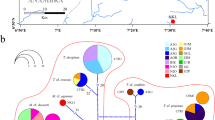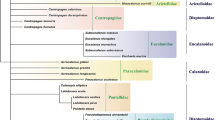Abstract
Baikalian cyclopoids represent one of the richest endemic faunas of freshwater cyclopoid copepods. The genus Diacyclops Kiefer, 1927 is the most numerous by species number in the lake. In this work, molecular-phylogenetic analysis of 14 species and 1 sub-species from Lake Baikal and its water catchment basin is performed. The regions of mitochondrial cytochrom-oxydase I (COI) and of nuclear small-subunit 18S rRNA were used as evolution markers. In the obtained set of COI gene sequences, an effect of synonymous substitution saturation is revealed. Baikalian representatives of the genus Diacyclops form at phylogenetic schemes by two markers a monophyletic group, it suggest their origin from a common ancestral form. Preliminary estimate of this group age is 20–25 My.
Similar content being viewed by others
References
Mazepova, G.F., Cyclops (Cyclopoida), in Annotirovannyi spisok fauny ozera Baikal i ego vodosbornogo basseina v 2 tomakh (Annotated Fauna of the Baikal Lake and Its Catchment Area in 2 Volumes), Timoshkin, O.A. Ed., Novosibirsk: Nauka, 2001, vol. 1, pp. 451–467.
Timoshkin, O.A., Baikal Lake: Fauna Diversity, Problems of Its Immiscibility and Origin, Ecology and “Exotic” Communities, in Annotirovannyi spisok fauny ozera Baikal i ego vodosbornogo basseina v 2 tomakh (Annotated Fauna of the Baikal Lake and Its Catchment Area in 2 Volumes), Timoshkin, O.A. Ed., Novosibirsk: Nauka, 2001, vol. 1, pp. 16–74.
Sheveleva, N.G. and Pen’kova, O.G., Zooplankton of the Southern Part of the Maloe More Strait (Baikal Lake), Biol. Vnutrennikh Vod, 2005, no. 4, pp. 42–49.
Mazepova, G.F., Tsiklopy ozera Baikal (Cyclops of the Baikal Lake), in Trudy Limnologicheskogo instituta (Transactions of the Limnology Institute), Novosibirsk: Nauka, 1978.
Dussart, B. and Deffae, D., World Directory of Crustacea Copepoda of Inland Waters: II. Cyclopiformes, Leiden: Backuys, 2006.
Folmer, O., Black, M., Hoen, W., et al., DNA Primers for Amplification of Mitochondrial Cytochrome c Oxidase Subunit I from Diverse Metazoan Invertebrates, Mol. Mar. Biotechnol., 1994, vol. 3, pp. 294–299.
Huys, R. Llewelin-Hughes, J., and Olson, D., et al., Small Subunit rDNA and Bayesian Inference Reveal Pectenophilus ornatus (Copepoda incertae sedis) as Highly Transformed Mytilicolidae, and Support Assignment of Chondracanthidae and Xarifiidae to Lichomolgoidea (Cyclopoida), Biol. J. Linnean Soc., 2006, vol. 87, pp. 403–425.
Kozhov, M.M., Biologiya ozera Baikal (Biology of the Baikal Lake), Moscow: Akad. Nauk SSSR, 1962.
Lee, S.Y. and Rasheed, S., A Simple Procedure for Maximum Yield of High-Quality Plasmid DNA, Bio-Techniques, 1990, vol. 6, pp. 676–679.
Kumar, S., Tamura, K., and Jakobsen, I.B., et al., MEGA2: Molecular Evolutionary Genetics Analysis Software, Bioinformatics, 2001, vol. 17, no. 12, pp. 1244–1245.
Rozas, J., Sanches-DelBarrio, J.C., Messeguer, X., and Rozas, R., DnaSP, DNA Polymorphism Analyses by the Coalescent and Other Methods, Bioinformatics, 2003, vol. 19, no. 18, pp. 2496–2497.
Guindon, S., Lethiec, S., Duroux, P., et al., PHYML Online—a Web Server for Fast Maximum Likelihood-Based Phylogenetic Inference, Nucleic Acids Res., 2005, vol. 33, p. W557–W559.
Ronquist, F. and Huelsenbeck, J.P., MRBAYES 3: Bayesian Phylogenetic Inference under Mixed Models, Bioinformatics, 2003, vol. 19, pp. 1572–1574.
Schubart, C.D., Diesel, R., and Hedges, B., Rapid Evolution to Terrestrial Life in Jamaican Crabs, Nature, 1998, vol. 393, pp. 363–365.
Knowlton, N. and Weight, L.A., New Dates and New Rates for Divergence across the Isthmus of Panama, Proc. R. Soc. London, 1998, vol. 265, pp. 2257–2263.
Gaunt, M.W. and Miles, M.A., An Insect Molecular Clock Dates the Origin of the Insects and Accords with Palaeontological and Biogeographic Landmarks, Mol. Biol. Evol., 2002, vol. 19, no. 5, pp. 748–761.
Lee, C.E., Global Phylogeography of a Cryptic Copepod Species Complex and Reproductive Isolation between Genetically Proximate “Populations”, Evolution, 2000, vol. 54, pp. 2014–2027.
Goetze, E., Cryptic Speciation on the High Seas; Global Phylogenetics of the Copepod Family Eucalanidae, Proc. R. Soc. London, 2003, vol. 270, pp. 2321–2331.
Roe, A.D. and Sperling, F.A.H., Patterns of Evolution of Mitochondrial Cytochrome c Oxidase I and II DNA and Implications for DNA Barcoding, Mol. Phylogenet. Evol., 2006, vol. 44, pp. 325–345.
Lefebure, T., Douady, C.J., Gouy, M., and Gibert, J., Relationship between Morphological Taxonomy and Molecular Divergence within Crustacea: Proposal of a Molecular Threshold to Help Species Delimitation, Mol. Phylogenet. Evol., 2006, vol. 40, pp. 435–447.
Karanovic, T., Two New Genera and Three New Species of Subterranean Cyclopoids (Crustacea, Copepoda) from New Zealand, with Redescription of Goniocyclops silvestris Harding, 1958, Contrib. Zool., 2005, vol. 74, nos. 3–4, pp. 223–254.
Monchenko, V.I., Cryptic Species in Diacyclops bicuspidatus (Copepoda: Cyclopoida): Evidence from Crossbreeding Studies, Hydrobiologia, 2000, vol. 417, no. 1, pp. 101–107.
Gressey, R. and Patterson, C., Fossil Parasitic Copepods from a Lower Cretaceous Fish, Science, 1973, vol. 180, pp. 1283–1285.
Huys, R. and Boxshall, G.A., Copepod Evolution, London: Ray Society, 1991.
Palmer, A.R., Miocene Copepods from the Mojave Desert, California, J. Paleontol., 1960, vol. 34, no. 3, pp. 447–452.
Boxshall, G.A. and Jaume, D., Making Waves: The Repeated Colonization of Fresh Water by Copepod Crustaceans, Adv. Ecol. Res., 2000, vol. 31, pp. 61–79.
River, I.K., Lazareva, V.I., and Gusakov, V.A., Mesofauna of the Upper Volga Water Storage Basins (1953–2001), in Ekologicheskie problemy Verkhnei Volgi (Ecological Problems of the Upper Volga), Yaroslavl, 2001, pp. 409–412.
Author information
Authors and Affiliations
Corresponding author
Additional information
Published in Russian in Genetika, 2010, Vol. 46, No. 11, pp. 1556–1564.
The article was translated by the authors.
Rights and permissions
About this article
Cite this article
Mayor, T.Y., Sheveleva, N.G., Sukhanova, L.V. et al. Molecular-phylogenetic analysis of cyclopoids (Copepoda: Cyclopoida) from Lake Baikal and its water catchment basin. Russ J Genet 46, 1373–1380 (2010). https://doi.org/10.1134/S102279541011013X
Received:
Accepted:
Published:
Issue Date:
DOI: https://doi.org/10.1134/S102279541011013X




